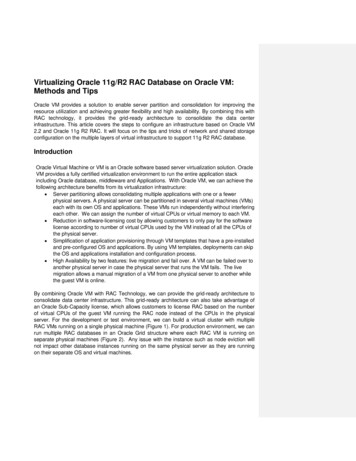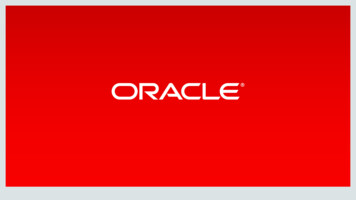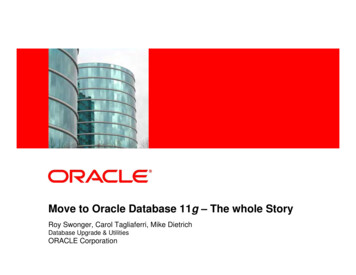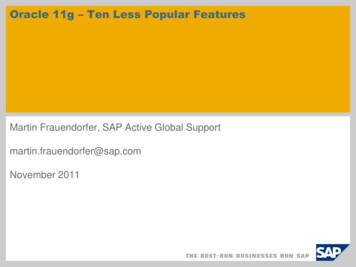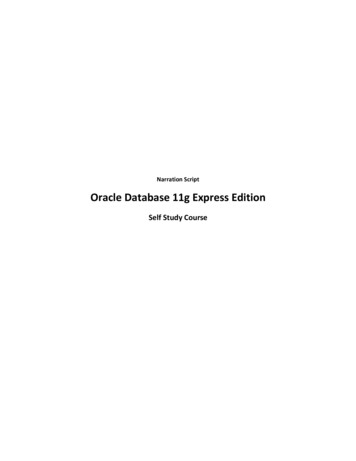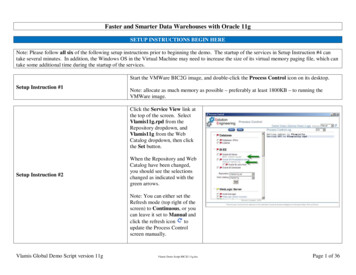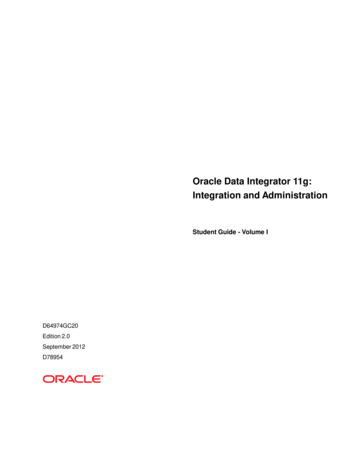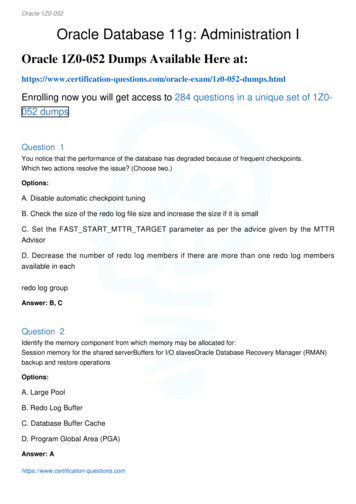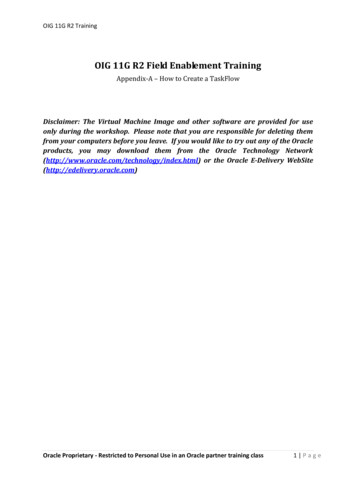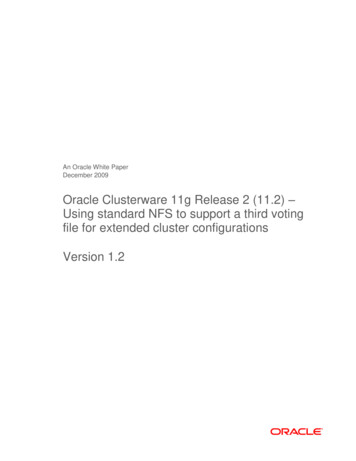
Transcription
An Oracle White PaperDecember 2009Oracle Clusterware 11g Release 2 (11.2) –Using standard NFS to support a third votingfile for extended cluster configurationsVersion 1.2
Oracle White Paper – Oracle Grid Infrastructure 11g Release 2Using standard NFS to support a third a voting file for extended cluster configurationsIntroduction . 2Extended or Campus Cluster . 4Voting File Usage . 4Voting File Processing . 5Setting up the NFS Server on Linux . 6Mounting NFS on the Cluster Nodes on Linux . 7Setting up the NFS Server on AIX . 8Mounting NFS on the Cluster Nodes on AIX . 9Setting up the NFS Server on Solaris . 11Mounting NFS on the Cluster Nodes on Solaris . 12Setting up the NFS Server on HP-UX . 12Mounting NFS on the Cluster Nodes on HP-UX . 13Adding a 3rd Voting File on NFS to a Cluster using NAS / SAN . 14Adding a 3rd Voting File on NFS to a Cluster using Oracle ASM . 16Configuring 3 File System based Voting Files during Installation . 22Known Issues . 23Appendix A – More Information . 241
Oracle White Paper – Oracle Grid Infrastructure 11g Release 2Using standard NFS to support a third a voting file for extended cluster configurationsIntroductionOne of the most critical files for Oracle Clusterware are the voting files. With OracleClusterware 11g Release 2, a cluster can have multiple (up to 15) voting files to provideredundancy protection from file and storage failures.The voting file is a small file (500 MB max.) used internally by Oracle Clusterware toresolve split brain scenarios. It can reside on a supported SAN or NAS device. In general,Oracle supports the NFS protocol only with validated and certified network file ailability/htdocs/vendors nfs.html)Oracle does not support standard NFS for any files, with the one specific exceptiondocumented in this white paper. This white paper will give Database Administrators aguideline to setup a third voting file using standard NFS.The first Oracle Clusterware version to support a third voting file mounted usingthe standard NFS protocol is Oracle Clusterware 10.2.0.2. Support has beenenhanced to Oracle Clusterware 11.1.0.6 based on successful tests. Usingstandard NFS to host the third voting file will remain unsupported for versionsprior to Oracle Clusterware 10.2.0.2. All other database files are unsupported onstandard NFS. In addition, it is assumed that the number of voting files in thecluster is 3 or more. Support for standard NFS is limited to a single voting fileamongst these three or more configured voting files only. This paper will focus onGrid Infrastructure 11.2.0.1.0, since starting with Oracle Clusterware 11.2.0.1.0Oracle Automatic Storage Management (ASM) can be used to host the voting files.THE PROCEDURES DESCRIBED IN THIS PAPER ARE CURRENTLYONLY SUPPORTED ON AIX, HP-UX, LINUX, SOLARIS.See table1 for a an overview of supported NFS Server and NFS client configurations.2
Oracle White Paper – Oracle Grid Infrastructure 11g Release 2Using standard NFS to support a third a voting file for extended cluster configurationsNFS ServerNFS clientMount option NFS ClientExports on NFS ServerLinux 2.6 kernelas a minimumrequirementLinux 2.6 kernelas a minimumrequirementrw,bg,hard,intr,rsize 32768,wsize 32768,tcp,noac,vers 3,timeo 600/votedisk*(rw,sync,all squash,anonuid 500,anongid 500)IBM AIX5.3ML4IBM AIX5.3ML4rw,bg,hard,intr,rsize 32768,wsize 32768,timeo 600,vers 3,proto tcp,noac,sec sys/votedisksec sys:krb5p:krb5i:krb5:dh:none,rw,access nfs1:nfs2,root nfs1:nfs2Linux 2.6 kernelas a minimumrequirementIBM AIX5.3ML4rw,bg,hard,intr,rsize 32768,wsize 32768,timeo 600,vers 3,proto tcp,noac,sec sys/votedisk*(rw,sync,all squash,anonuid 300,anongid 300)Sun Solaris 10SPARCSun Solaris 10SPARCrw,hard,bg,nointr,rsize 32768,wsize 32768,noac,proto tcp,forcedirectio,vers 3/etc/dfs/dfstab :share -F nfs -o anon 500 /votediskHP-UX 11.31(minimumrequirement – allHP-UX versionsprior to 11.31are unsupported)HP-UX 11.31(minimumrequirement – allHP-UX versionsprior to 11.31 areunsupported)rw,bg,hard,intr,rsize 32768,wsize 32768,timeo 600,noac,forcedirectio 0 0/etc/dfs/dfstab :share -F nfs -o anon 201 /votediskLinux 2.6 kernelas a minimumrequirementHP-UX 11.31(minimumrequirement – allHP-UX versionsprior to 11.31 areunsupported)rw,bg,hard,intr,rsize 32768,wsize 32768,timeo 600,noac,forcedirectio 0 0/votedisk*(rw,sync,all squash,anonuid 201,anongid 201)Note 1:Linux, by default, requires any NFS mount to use a reserved port below 1024. AIX, by default, uses portsabove 1024. Use the following command to restrict AIX to the reserved port range:Note 1:# /usr/sbin/nfso –p -o nfs use reserved ports 1Without this command the mount will fail with the error: vmount: Operation not permitted.Table 1: Supported NFS server / client configurations3
Oracle White Paper – Oracle Grid Infrastructure 11g Release 2Using standard NFS to support a third a voting file for extended cluster configurationsExtended or Campus ClusterIn Oracle terms, an extended or campus cluster is a two or more node configuration where thenodes are separated in two physical locations. The actual distance between the physical locations,for the purposes of this discussion, is not important.Voting File UsageThe voting file is used by the Cluster Synchronization Service (CSS) component, which is part ofOracle Clusterware, to resolve network splits, commonly referred to as split brain. A “split brain”in the cluster describes the condition where each side of the split cluster cannot see the nodes onthe other side.The voting files are used as the final arbiter on the status of the configured nodes (either up ordown) and are used as the medium to deliver eviction notices. That means, once it has beendecided that a particular node must be evicted, it is marked as such in the voting file. If a nodedoes not have access to the majority of the voting files in the cluster, in a way that it can write adisk heartbeat, the node will be evicted from the cluster.As far as voting files are concerned, a node must be able to access more than the half of thevoting files at any time (simple majority). In order to be able to tolerate a failure of n voting files,one must have at least 2n 1 configured. (n number of voting files) for the cluster. Up to 15voting files are possible, providing protection against 7 simultaneous disk failures. However, it'sunlikely that any customer would have enough disk systems with statistically independent failurecharacteristics that such a configuration is meaningful. At any rate, configuring multiple votingfiles increases the system's tolerance of disk failures (i.e. increases reliability).Extended clusters are generally implemented to provide system availability to protect from sitefailures. The goal is that each site can run independently of the other one when one site fails.The problem in a stretched cluster configuration is that most installations only use two storagesystems (one at each site), which means that the site that hosts the majority of the voting files is apotential single point of failure for the entire cluster. If the storage or the site where n 1 votingfiles are configured fails, the whole cluster will go down, because Oracle Clusterware will loosethe majority of voting files.To prevent a full cluster outage, Oracle will support a third voting file on an inexpensive, lowend standard NFS mounted device somewhere in the network. Oracle recommends putting theNFS voting file on a dedicated server, which belongs to a production environment.4
Oracle White Paper – Oracle Grid Infrastructure 11g Release 2Using standard NFS to support a third a voting file for extended cluster configurationsFigure 2: Extended RAC environment with standard NFS Voting file in third siteVoting File ProcessingDuring normal operation, each node writes and reads a disk heartbeat at regular intervals. If theheartbeat cannot complete, the node exits, generally causing a node reboot.As long as Oracle has enough voting files online, the node can survive. But when the number ofoffline voting files is greater than or equal to the number of online voting files, the ClusterCommunication Service daemon will fail, resulting in a reboot.The rationale for this is that as long as each node is required to have a majority of voting filesonline, it is guaranteed that there is one voting file that both nodes in a 2 node pair can see.5
Oracle White Paper – Oracle Grid Infrastructure 11g Release 2Using standard NFS to support a third a voting file for extended cluster configurationsSetting up the NFS Server on LinuxTHIS CONFIGURATION is CURRENTLY ONLY SUPPORTED ON LINUXMinimum Kernel version is 2.6For setting up the NFS server the UID of the software owner and GID of the DBA group arerequired. The UID and GID should be the same on all the cluster nodes. In order to get theUID and GID of the Oracle user, issue the id command as the Oracle software owner (e.g.oracle) on one of the cluster nodes. To simplify reading this paper we assume that the softwareowner for the Grid Infrastructure (GI user) and the software owner for the RDBMS part is thesame. iduid 500(oracle) gid 500(dba) groups 500(dba)In this case the UID is 500 and the GID is also 500.As root, create a directory for the voting file on the NFS server and set the ownership of thisdirectory to the UID and the GID obtained for the Oracle software owner:# mkdir /votedisk# chown 500:500 /votediskAdd this directory to the NFS exports file /etc/exports.This file should now contain a line like the following:/votedisk *(rw,sync,all squash,anonuid 500,anongid 500)The anonuid and anongid should contain the UID and GID determined for the GI userand the ASMDBA group on the cluster nodes (here: 500 for UID and 500 for GID)Check that the NFS server will get started during boot of this server.For RedHat Linux the respective check is performed as follows:chkconfig --level 345 nfs onNow, start the NFS server process on the NFS server.For RedHat Linux the respective command is:service nfs startIf the new export directory is added to the /etc/exports file while the NFS server process wasalready running, restart the NFS server or re-export with the command “exportfs –a”.6
Oracle White Paper – Oracle Grid Infrastructure 11g Release 2Using standard NFS to support a third a voting file for extended cluster configurationsCheck, if the directory containing the voting files is exported correctly by issuing theexportfs –v command as shown below:# exportfs -v/votedisk world (rw,wdelay,root squash,all squash,anonuid 500,anongid 500)Mounting NFS on the Cluster Nodes on LinuxTo implement a third voting file on a standard NFS mounted drive, the supported and testedmount options are: rw,bg,hard,intr,rsize 32768,wsize 32768,tcp,noac,vers 3,timeo 600The minimum Linux kernel version supported for the NFS server is a 2.6 kernel.To be able to mount the NFS export, create an empty directory as the root user on each clusternode named /voting disk. Make sure, the NFS export is mounted on the cluster nodes duringboot time by adding the following line to the /etc/fstab file on each cluster node:nfs-server01:/votedisk/voting disk nfsrw,bg,hard,intr,rsize 32768,wsize 32768,tcp,noac,vers 3,timeo 600 0 0Mount the NFS export by executing the mount /voting disk command on each server.Check, if the NFS export is correctly mounted with the mount command.This should return a response line as shown below:# mountnfs-server01:/votedisk on /voting disk type nfs(rw,bg,hard,intr,rsize 32768,wsize 32768,tcp,noac,nfsvers 3,timeo 600,addr 192.168.0.10)7
Oracle White Paper – Oracle Grid Infrastructure 11g Release 2Using standard NFS to support a third a voting file for extended cluster configurationsSetting up the NFS Server on AIXFor setting up the NFS server the UID of the software owner and GID of the DBA group arerequired. The UID and GID should be the same on all the cluster nodes. In order to get theUID and GID of the Oracle user, issue the id command as the Oracle software owner (e.g.oracle) on one of the cluster nodes: iduid 500(oracle) gid 500(dba) groups 500(dba)In this case the UID is 500 and the GID is also 500.As root, create a directory for the voting file on the NFS server and set the ownership of thisdirectory to the UID and the GID obtained for the Oracle software owner:# mkdir /votedisk# chown 500:500 /votediskAdd this directory to the NFS exports file /etc/exports.This file should now contain a line like the following:/votedisk sec sys:krb5p:krb5i:krb5:dh:none,rw,access nfs1:nfs2,root nfs1:nfs2Check that the NFS server will get started during boot of this server.On AIX, check the /etc/inittab for the rcnfs start:# cat /etc/inittab grep rcnfsrcnfs:23456789:wait:/etc/rc.nfs /dev/console 2 &1 # Start NFSDaemonsIf the NFS Server is not configured , use smitty to complete the configuration:# smitty nfsChoose “Network File System (NFS)” “Configure NFS on ThisSystem” “Start NFS”Check for “START NFS now, on system restart or bothchooseboth”If the new export directory is added to the /etc/exports file while the NFS server process wasalready running, restart the NFS server or re-export with the command “exportfs –a”.8
Oracle White Paper – Oracle Grid Infrastr
Oracle White Paper – Oracle Grid Infrastructure 11g Release 2- Using standard NFS to support a third a voting file for extended cluster configurations 4 Extended or Campus Cluster In Oracle terms, an extended or campus cluster is a two or more node configuration where the nodes are separated in two physical locations. The actual distance between the physical locations,
